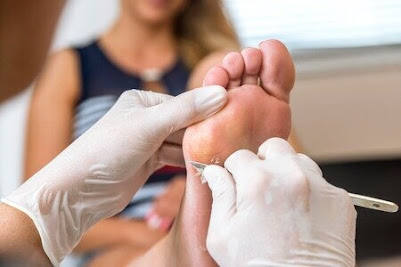Essential Details Regarding Corns and Low Laser
Essential Details Regarding Corns
Many people
suffer from corn on their feet because it's a prevalent condition. Corns are
particularly painful, so it is recommended that the issue be addressed
immediately to prevent it from becoming more severe. Corns can be formed in
various ways. Most often, it's because of the friction and heat placed on the
skin, causing the body to react by thickening the region. If the pressure is
maintained, the callous becomes more prominent and extensive. It could develop
into a corn that could be able to encase itself in skin epidermal layers.
If you've
ever experienced foot corn, then you know Corns in Charters Towers. The growths on the skin are caused
by friction around the feet, mainly the time due to shoes. Different types of
footwear and shoes can cause corn on the feet.
Corns on Feet Removal
The best
option is to wear comfortable shoes. Scholl is a good pair of shoes known to be
healthy and comfortable. They might be costly, but it's worth it. Suppose the
root of the corn on the feet is eliminated. In that case, the corn will
gradually diminish, and the removal will be simple. Plenty of steel
"graters" or pads are abrasive and can aid in the removal.
When your
finances are small, a simple sandpaper might be the answer. A few
over-the-counter products can accomplish the trick as well. The most important
thing is to keep the entire affected area clean and bacterium free. Always
sterilize the area with alcohol and then apply bactericide.
Don't use
cutting blades to remove the corn on your feet. It's hard to tell the depth of
cut the blade makes. The blade can be difficult to control. The best method of
getting rid of corn is to use the use of abrasion or Salicylic Acid.
Low-Level Laser Light Therapy
INTRODUCTION
Low-Level
Laser Light Therapy (LLLT) is an internationally recognized term used for
biostimulator that uses low-energy lasers to produce therapeutic effects.
Typically, LLLT falls under the category of Physical Medicine, which uses
stimulation therapy to trigger the body's defense mechanisms. If LLLT is the
trigger and treatment method, it is called photobiostimulation.
Low lazer Richmond Hill has been used to treat
physical/manual medicine, sports medicine, dermatology, and neuroendocrine
disorders for animal and human patients. The anti-inflammatory and analgesic
qualities of LLLT and its effects on collagen production are excellent reasons
to use LLLT in traumatology, surgery, and dentistry, particularly after
significant surgery.
MEDICAL LASERS
There are a
variety of medical lasers on the market, and they are classified into two major
categories:
High-power
lasers cut through coagulation and evaporate tissues. They are also referred to
in the field of Surgical Lasers because they replace the scalpel that surgeons
use. Lasers emit photons (light) that are high-energy.
Low-level
lasers boost the cell's function. They do not cause thermal damage like that of
surgical lasers. Non-surgical therapeutic lasers are classified as class 3A
through the FDA. The energy created by photons produced by these lasers is
minimal. It does not contain an element of thermal energy that can cause injury
to users or users. This energy is low in level and doesn't alter the molecular
structures; however, it stimulates the body's mechanisms for repair and healing
itself.
The
chromophores inside cells absorb low-level (energy) laser photons of light.
This causes an increase in cells' energy in the form of ATP and leads to the
normalization of cell functions as well as pain relief and healing. These
effects are particularly noticeable on the body that is experiencing stress.
The photon
energy produced by these low-level lasers is deficient. It is far below the
levels needed to ionize the molecules and atoms of cells. Therefore, no cancer
has been linked to these beams. Eye injury risk is virtually non-existent.
However, glasses are highly advised.
EFFECTS OF LLLT
(1) The
scalp has a higher blood circulation, and microcirculation increases by 20-30%.
(2)
Increases supply of nutrients to boost hair growth
(3) It
stimulates and speeds up hair growth.
(4) stops
the development of hair loss
(5) Improves
and repairs hair shaft quality
(6) Reduces
the excess alpha 5 skin reductase and DHT that contribute to genetic thinness.
(7) Helps
with scalp problems like seborrheic scalp dermatitis, and itchy scalp
(anti-inflammatory properties)
(8) Sebum
production is normalized (also boosts production in areas of low activity and
dryness, and reduces production when overactive or greasiness)
(9) Reduces
the tight, tender scalp





Comments
Post a Comment